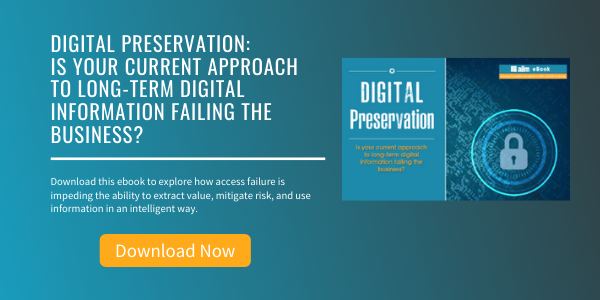
Digital Preservation – High Stakes for Finance and Insurance Companies
Accounting and Finance | Insurance | Digital Preservation
In Digital Preservation -- Is your current approach to long-term digital information failing the business? I wrote that our two key information management objectives — utilization of information and preservation of it — got separated along the digital journey. In the process, long-term preservation of digital information took a backseat to the short-term utilization and optimization of this information in business processes. In addition, many organizations lost track of the key differences between back-up, archiving, and true long-term preservation.
We define digital preservation as “the capabilities to ensure the readability and usability of digital information that must be retained for longer than 10 years.”
It is time to think about Digital Preservation differently — as a dedicated capability that keeps long-term information alive and usable and trusted and easily found. The time to act is now. AIIM believes that digital preservation needs to be viewed through the prism of a set of Intelligent Information Management capabilities that are integral to delivering upon the Digital Transformation challenge of understanding, anticipating, and redefining internal and external customer experiences.
Nowhere is this truer than in the financial services sector. In a recent AIIM survey, 85% of finance and insurance executives said that digital preservation was “important” or “very important” to their organizations – even higher than the 77% reported in other industries.
Despite this declared importance – 62% say that “Archiving and long-term digital preservation is a key part of our enterprise information governance and management strategy” -- the reality in most financial organizations is very different. Their confidence in ensuring the readability and usability of digital information of digital information that must be retained for longer than 10 years is lagging, indicating concerns that traditional IT strategies focused on backups and archiving are just not good enough to prevent the loss of near-term corporate history or to release potential value trapped in longterm digital information.
| 52% | Ensuring the readability of digital information in the future is an afterthought for us. |
| 76% | Digital records are at constant risk of not being findable, readable or useable when required. |
| 67% | Digital information that must be kept for 10 years or longer is inherently at risk due to changes in technology and file formats. |
This lack of confidence also suggests gaps in the functionality of traditional records and content management solutions – 57% of financial sector executives say “Our content systems do not have effective records disposition policies and controls.”
Of course, a deliberate focus on Digital Preservation capabilities ought to be a conscious Intelligent Information Management priority in every industry. But why is it particularly important in finance and insurance? Here are three key reasons.
1. The financial services sector is the most highly regulated and competitive sector on the planet.
Ensuring long-term digital information is immediately accessible, trustworthy and available over decades allows financial services organizations to innovate and outsmart the competition, sustain long-term customer relationships, build brand reputation and value, provide evidence in legal disputes, and meet increasingly stringent privacy and FINRA, FCA, PRA and EU regulations, including MiFID II and GDPR.
Per Lexology (Document Retention Policy for Banks):
“Document retention sounds like a boring topic until you realize that your bank can be subject to huge monetary damages and possible regulatory action if it doesn’t handle document retention correctly. In the old days, banks could simply keep every document forever to be on the safe side. That isn’t a practical alternative in today’s environment. Nowadays, retaining documents after their useful date can actually harm the bank.”
The long-term information management regulatory requirements characteristic of the financial services sector are many and growing, and include (just in the U.S.!) the Equal Credit Opportunity Act, Truth in Lending Act, Truth in Savings Act, Electronic Funds Transfer Act, Bank Secrecy Act, Payment Card Industry Data Security Standard (PCI-DSS), Gramm-Leach-Bliley Act (GLBA), Sarbanes-Oxley and many others. This information includes core business information – like records of corporate governance, contracts and agreements, acquisitions and mergers, HR and employee records, and unique brand and marketing assets – as well as sector-specific information – like master policies (with retention of 25 years), pension plans, and beneficiary files in insurance (with retention of 75 years or more).
The long-term digital information that global financial services organizations need or want to keep for longer than 10 years can run into millions of files in hundreds of different formats. The complexity and volume of long-term digital information assets is on the rise as digital transformation, application retirement and paper to digital initiatives gather momentum.
2. Potential opportunities created by tapping into the value of long-term information are significant.
The volume and diversity of digital information in the financial services sector continues to increase exponentially - this requires an at scale solution for ensuring vital long-term records can be found, used and trusted when required. Rapid changes in technology – and the potential this creates for enhancing the customer experience and generating new lines of business means that many legacy applications will be retired – creating a need for a safe home for the critical long-term information they contain. It also means that financial institutions must consciously think of ways to avoid the high-risk “big-bang” approach of waiting to the next system migration -- when the context and value of the original information may be unclear.
Risk mitigation and compliance are only part of the reason for financial institutions to build a sound digital preservation strategy. In Rethinking the enterprise data archive for big data analytics and regulatory compliance, Ashar Baig from GigaOm raises the bar for the importance of digital preservation: “In the past, historical data was archived mainly for regulatory compliance purposes. Today businesses often analyze their historical data against current data sets so they can derive a competitive advantage and better understanding of their customers while also generating incremental revenue.” Financial sector companies are realizing that “analyzing historical data and possibly combining it with current or real-time data could generate revenue,” and as a result, “Time-to-information (TTI) is the most critical criterion that businesses use to benchmark their big data analytics and archiving platforms.”
3. Potential opportunities tied to digital preservation are not confined to just big data.
Many of the world’s largest banks and insurance companies have been in operation for 100 years or more, and their reputations and brand value are closely associated with reliability and sustainability. For example, HSBC is one of the largest financial services organizations in the world. Founded in 1865 in Hong Kong to finance trade between Europe and Asia, the bank now serves around 46 million customers and operates in more than 70 countries and territories. The net-net of this rich history is a set of information assets and intellectual property with great accumulated value.
Given this long history, the bank’s archives are a mix of analog, digitized and born digital content, that includes letters, photographs, brand assets, films, advertising, banknotes, predecessor company files, architectural drawings and staff interviews – all of which shed light on the social, economic and political history of those communities and countries where the bank has done business. In managing these collections , the bank must deal with over 800 different file formats, 300+ migration workflows and synchronization of metadata between physical and digital materials.
HSBC recognized that ensuring accessibility and authenticity of this digital information over successive technology cycles and custodians requires a dedicated digital preservation strategy and system that could not be accommodated using traditional backup, archiving, storage or content management.
About John Mancini
John Mancini is the President of Content Results, LLC and the Past President of AIIM. He is a well-known author, speaker, and advisor on information management, digital transformation and intelligent automation. John is a frequent keynote speaker and author of more than 30 eBooks on a variety of topics. He can be found on Twitter, LinkedIn and Facebook as jmancini77. Recent keynote topics include: The Stairway to Digital Transformation Navigating Disruptive Waters — 4 Things You Need to Know to Build Your Digital Transformation Strategy Getting Ahead of the Digital Transformation Curve Viewing Information Management Through a New Lens Digital Disruption: 6 Strategies to Avoid Being “Blockbustered” Specialties: Keynote speaker and writer on AI, RPA, intelligent Information Management, Intelligent Automation and Digital Transformation. Consensus-building with Boards to create strategic focus, action, and accountability. Extensive public speaking and public relations work Conversant and experienced in major technology issues and trends. Expert on inbound and content marketing, particularly in an association environment and on the Hubspot platform. John is a Phi Beta Kappa graduate of the College of William and Mary, and holds an M.A. in Public Policy from the Woodrow Wilson School at Princeton University.



